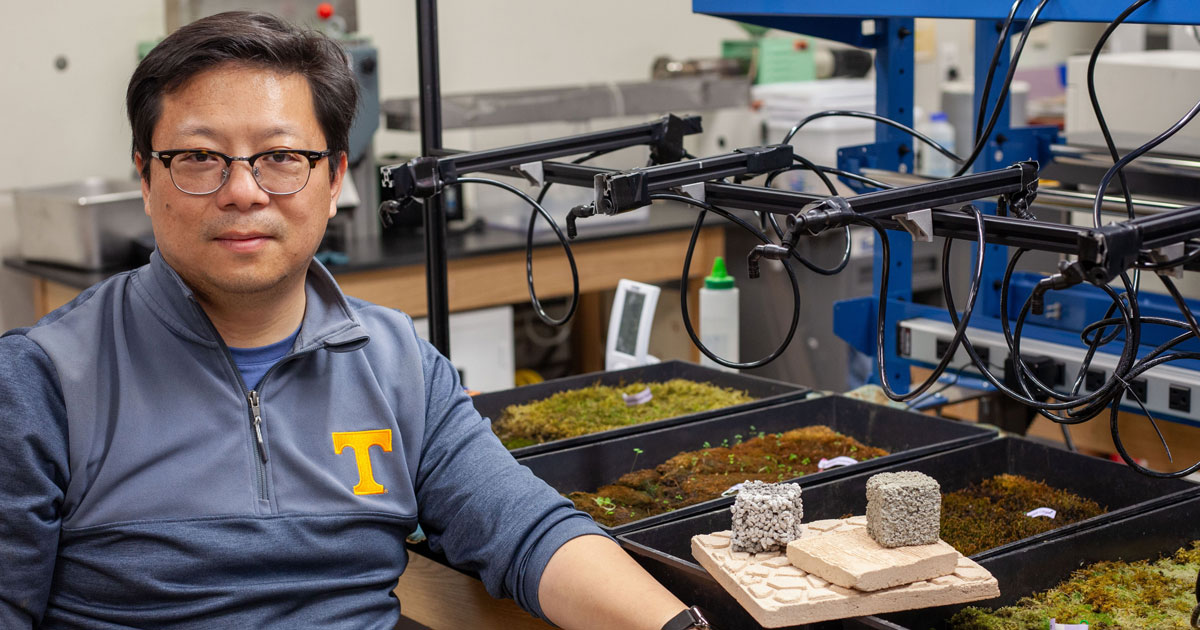Young Faculty Award Supports Zhou’s Eco-Minded Plan
The entire country faced record high temperatures in the summer of 2023, along with record numbers of heat-related illnesses. But towering above rural and suburban records were the urban heat islands—bubbles of heat that surround cities, increasing the experienced temperature by up to five degrees Celsius (eight degrees Fahrenheit).
“Urbanization drastically changes the landscape,” said Associate Professor Nick Zhou, a materials scientist specializing in sustainable building systems. “Most urban land is covered by impervious paved surfaces like concrete and asphalt, which disrupt many natural processes, including the water cycle.”
In hot weather, plants and natural surfaces dissipate heat very effectively through transpiration and evaporative cooling. Paved surfaces like those in cities or military bases trap heat instead.
It is common to try fighting the heat by bringing vegetation back into urban centers, usually by installing infrastructure like green roofs. Unfortunately, these solutions tend to rely on vascular plants like trees, shrubs, and grasses, all of which require soil and irrigation.
Wet soil is heavy, increasing the strain on roofs, while irrigation requires maintenance and the use of water, an increasingly scarce resource. However, Zhou considers the most limiting aspect of green roofs to be their limitation to horizontal areas.
“Most of the paved surface of a city is vertical,” he said, “so we would get the most benefit from enlivening building surfaces. But grass cannot grow on vertical surfaces.”
Fortunately, Zhou has an alternative. He plans to use plants that are as happy on sheer cliff faces as they are on the forest floor—and make them part of the very walls.
Mosses do not have root systems, instead absorbing water from their aerial tissues, and can cling to a variety of impervious surfaces like concrete and rock. They are also highly desiccation tolerant, able to survive losing more than 80 percent of their internal water. Mosses and similar organisms form stable communities that can persist for decades, thriving in harsh environments without significant maintenance or irrigation.
Zhou envisions cities blanketed in cooling moss. Working with UT students and researchers, he has begun designing Phyto-activated functional Living Materials (PhantoMs)—bioreceptive support materials that mimic a moss’s preferred microenvironment. Once inoculated with moss, PhantoMs easily turn any constructed surface into a moss garden.
“Bioreceptive construction integrates living organisms into architecture,” he said. “What makes PhantoM fundamentally different is that we’re trying to make the entire surface of the building bioreceptive.”
This fall, Zhou received a prestigious 2023 Young Faculty Award (YFA) from the Defense Advanced Research Projects Agency (DARPA). The YFA is an annual competitive award supporting elite, early-career researchers creating transformational solutions to national security challenges.
Since the YFA program began in 2006, DARPA has bestowed almost 500 awards—but Zhou’s is only the third granted to a researcher in the state of Tennessee.
In addition to funding PhantoM’s further development, the YFA gives Zhou access to a DARPA mentor and connections with experts in many branches of the US government.
PhantoM addresses DARPA’s goal to develop innovative native landscaping methods that can cool acre-scale spaces by three to five degrees Celsius within one year of installation.
“The YFA is a highly competitive environment where projects are executed in a relatively short timeframe,” Zhou said. “It’s designed to be bold and aggressive, which is very well suited to our goals with PhantoM.”
As PhantoM dries, its surface takes on a cell-like structure that soaks up rainwater, then slowly releases it for moss to access. Altering PhantoM’s microstructure can make it adaptive to certain climates, changing the amount of water it retains, how slowly the water is released, or how much air can circulate within the material.
Preliminary field tests have shown tremendous promise for the cooling potential of the PhantoM system; when hydrated, the moss tiles reduced building surface temperatures by up to 18 degrees Celsius on a hot summer day.
Zhou hopes that PhantoM can be made into cladding panels for new construction or applied like plaster to retrofit existing buildings. Because mosses can be propagated from tissue samples, Zhou is also investigating new ways of inoculate moss on large constructed surfaces—like spraying a moss slurry over a building’s surface like paint.
“The big dream here is to turn buildings into ‘trees’,” he said. “By working with nature instead of against it, we could efficiently decarbonize our cities, preserve biodiversity in urban areas, and provide a more comfortable living environment. We want to reimagine the urban landscape.”
Contact
Izzie Gall (865-974-7203, [email protected])

